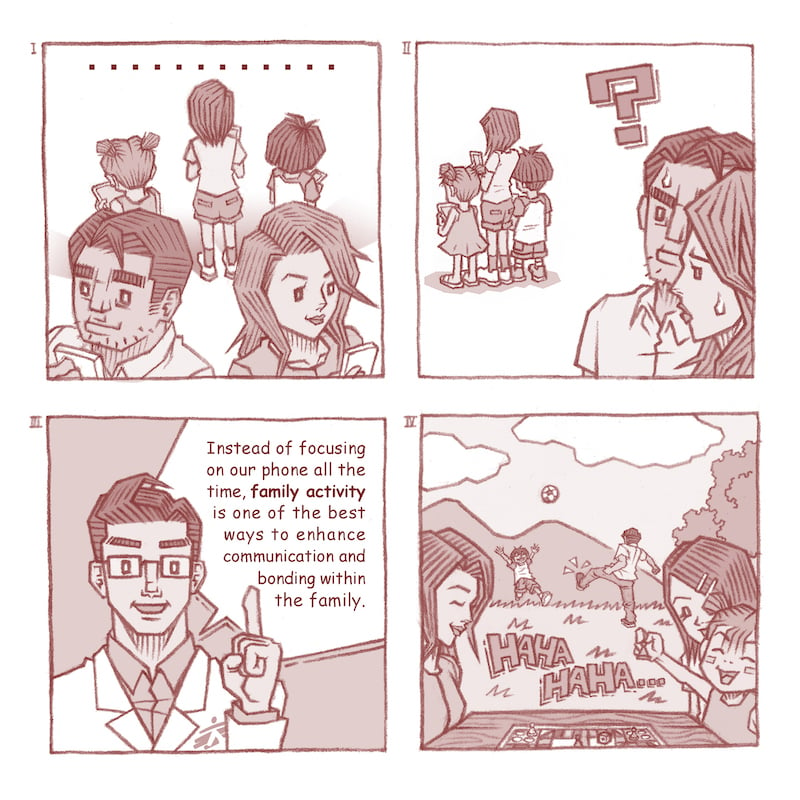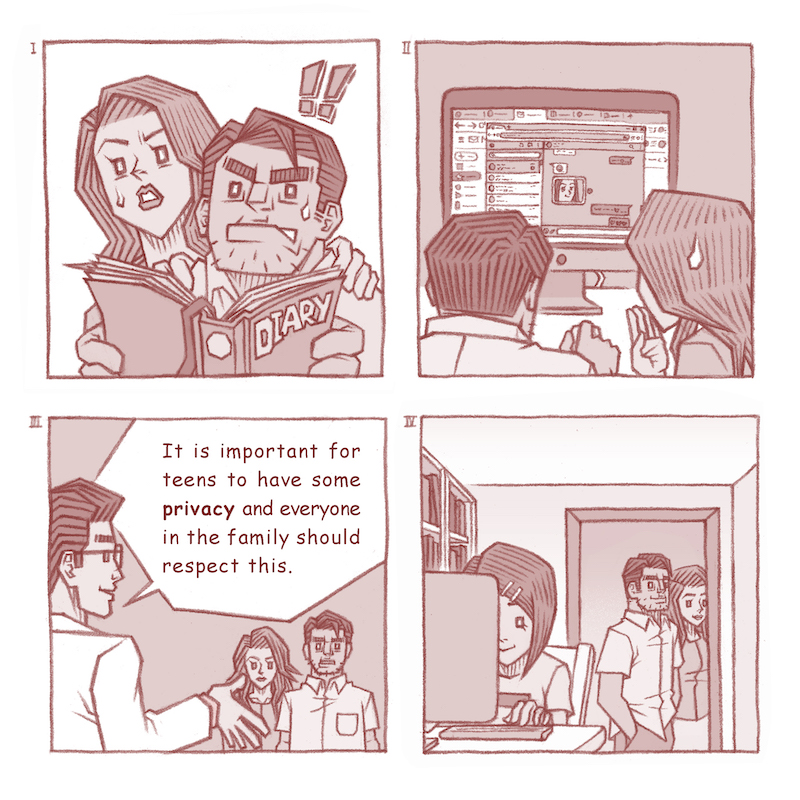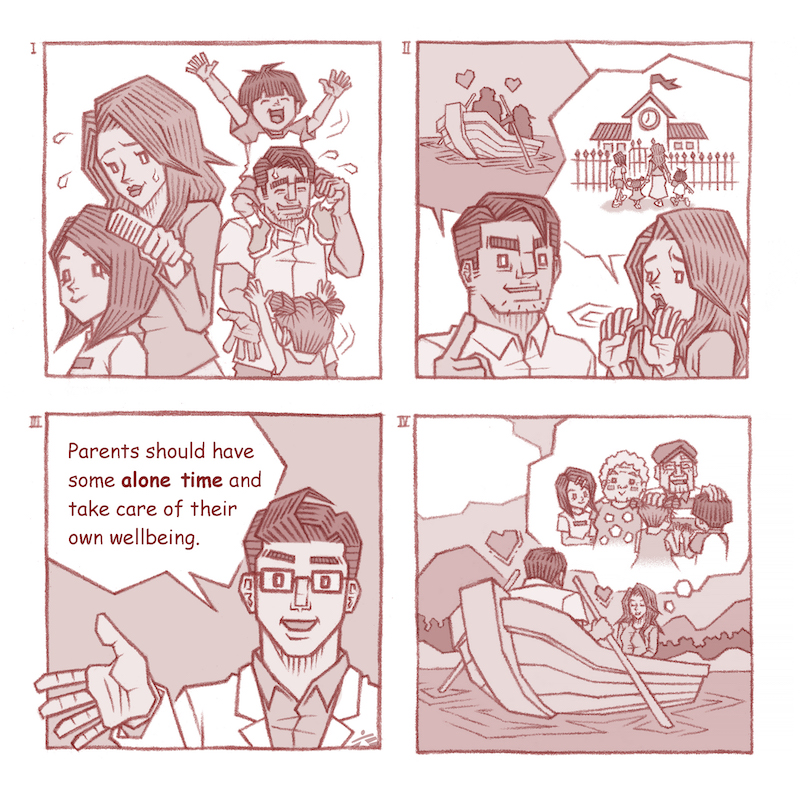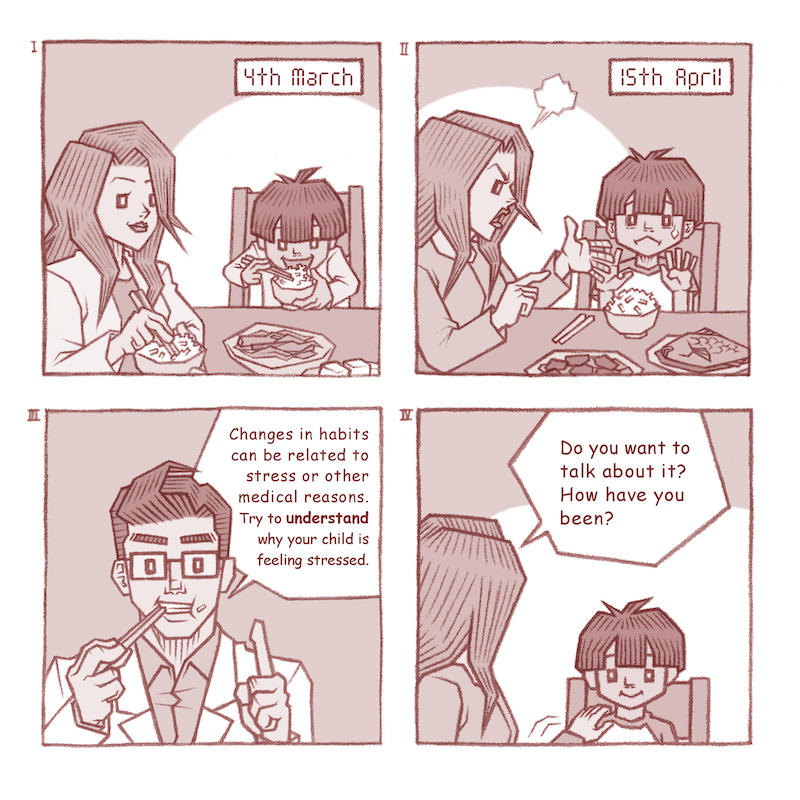INTRODUCTION
Home is our security blanket that protects us from external threats. But to work, it needs the collective effort of every member of the family. Only when we truly look after each other will the home give us that warm security. Have you come across similar situations to those we’re about to see in a family setting? Let’s take a look at how this family builds up their family resilience with the advice of an MSF psychologist.
FAMILY ACTIVITY

Resilience is really the ability to “bounce back” to healthy functioning when faced with events that cause stress. So family resiliency is about being able to cultivate strengths as a family unit to meet the challenges of life positively. Family resilience helps us to develop protection mechanisms against experiences which might otherwise be overwhelming. It helps us to maintain balance in our lives during difficult or stressful periods.
Family activities that involve communication are a great way to grow family resilience because that’s the key in all human relationships. And developing family traditions and habits of regular family activities. For example, playing boardgames, hiking or doing yoga together at home are excellent ways to build up bonding and tune your communications channels with each other; especially games that focus on teamwork, problem-solving and communicating!
Preschool: Toddlers may not able to express their stress? Click here to learn more tips for parents
RESPECT BOUNDARIES
Rules and boundaries play an important part in family relationships. Boundaries are the set of guidelines that family members follow, for example, to respect each other’s privacy. It’s especially important for teenagers to feel that their privacy is being respected within the family. When children start secondary school, parents should ask for permission before doing things like going through their school bags. They should knock before going into their room and stop peeking into their phone conversations with friends. This not only increases the teenager’s sense of security and avoids unnecessary conflict within the family, but it’s also a way for them to learn that these are real social skills – boundaries – with their peers.
Now of course parents also want to be sure that they are protecting their children from external threats and online abuse. So all this needs to be weighed when setting boundaries. Respecting privacy doesn’t have to mean that you allow them to do what they want online. Monitoring content consumption or installing parental control software in their computer or smartphone are certainly things to consider.
Adolescents: Parental worry VS respect? Click here to learn more tips for parents

“ALONE TIME” FOR PARENTS

Being a parent can be as stressful as having a full-time job. So in the same way that we need holidays from work to recharge ourselves, we also need time and space away from the children. Parents sometimes feel guilty, worrying that they are doing something wrong if they spend time alone or with their partner but without their children. The truth is, children will grow up healthier emotionally when their parents are happy and fulfilled.
It’s not always easy to make time for ourselves once we become a parent. But there are all sorts of ways to schedule some alone time for ourselves. It doesn’t have to be “romantic time” with your spouse, although that would be a great idea. It can be as little as a few minutes a day or several hours a week. For instance, try getting up 15 minutes before the rest of the family to listen to some music on your headphones, or take a lunchtime exercise class in a gym.
Parents: Please take care of yourself! Click here to learn more tips for you
FAKE NEWS
Social media are inseparable from our modern life and take a large part of our attention in a family. But they can be disruptive and even dangerous when they spread fake news. Sometimes there are conflicting opinions from what look like experts or confusing advice about public health. The language may be trying to create fear or anger or division.
So it’s especially important for family members to help each other to identify fake news and misinformation. We recommend a few steps that might help.
1. Check the news source:
For example, is the information coming from a trustworthy site originally? Is the author known in other reputable news sites? Not everyone will agree on which is absolutely the best news source but check that it comes from or is repeated by at least one of them.
2. Develop a critical attitude
Be aware of what is called “confirmation bias”, that is our tendency to unconsciously choose information that agrees with our existing beliefs. Try to challenge yourself about why you should believe it. Especially if the message comes from a news source that you do not recognise and you can’t find it anywhere else, it’s always good to ask the following question: Could there be a hidden agenda behind them spreading the news? For example, to sell specific products.
3. Rely on one or two very solid sources:
When it comes to really important issues like elections or global emergencies such as the COVID-19 pandemic, there are all kinds of reports everywhere. We recommend sticking to one or two reliable news sources such as the World Health Organization or the Centre for Health Protection.
It is very important for us to fact check the news in the social media before spreading it.
Adolescents: Parental worry VS respect? Click here to learn more tips for parents

STRESS SYMPTOMS IN PRE-SCHOOL CHILDREN 1,2,3

Stressful situations can have a big impact on the minds and the behaviour of young children. Staying at home without being able to go out, separation from their friends and from their wider family or watching disturbing news reports can all affect children’s behaviour and mood. They can produce mood swings, irritability, opposition to adults, feelings of sadness and fear, trouble sleeping, change in appetite or regressive behaviours (showing behaviours that they have grown out of). These are signs that tell us the child might be suffering from stress.
It can be difficult for your children to express their stress if they are too young. However, numerous studies have shown that the power of touch between parent and child can strengthen resiliency and increase trust, especially for children feeling anxious. Physical affection, like hugging children or holding their hands, can be stress-relieving for them and increase their sense of security.
Please do though think about the risks in the COVID-19 pandemic and pay extra attention to personal hygiene and preventive measures.
Preschool: Toddlers may not able to express their stress? Click here to learn more tips for parents
COMMON STRESS SYMPTOMS IN ADOLESCENTS
Adolescents sometimes refuse to admit that they feel stressed and may avoid talking about it. What can caregivers do to help children and adolescents? To begin with, it is fundamental to communicate with your children and explain the difficult medical situation, for example. You need to choose the right words for their age, so they can continue trusting adults, while at the same time we have to be careful not to hand them our anxiety and worries.
But if they still refuse to talk about it, we should give them some space and help to create a respectful and loving family environment for them. We can do that by letting them know that we understand how difficult it is for them and showing that if they need help, they can always come to you. You could say, “I can see that you are under a lot of stress. I am worried about you. But it’s fine that you don’t want to talk about it now. When you do feel you need someone to talk to, I am always here for you.”
Adolescents: Parental worry VS respect? Click here to learn more tips for parents

STRESS SYMPTOMS (ALL AGES)

Our sleeping and eating cycles often change when we are under stress. This behaviour is related to the ‘fight’ or ‘flight’ response we have as a survival instinct. Imagine if a tiger is chasing you in the jungle; you wouldn’t be thinking about sleeping or eating. You would just want to escape from it as soon as possible. And your body is preparing you for that with the digestive system shutting down, an increase in heart rate and blood flooding to your muscles. That’s why we have changes in our appetite and sleeping patterns. So instead of forcing your children back to their routine, you should try to locate the source of their stress. Showing them your care and companionship is an excellent way to help them through difficult times. If the symptoms persist, then the issue could be medical and you should look for professional medical help at that point.
We can show our care by asking them “I have notice that you have been losing appetite. Is there anything wrong? Do you want to talk about it?”
Primary School: Understand their stress. Click here to learn more tips for parents
VIDEO GAMING 4,5
We might have a preconceived notion that video games are just bad for our children. But playing video games and surfing the internet can be an effective ways for children to relieve some of their stress and socialise with their friends. Research conducted at Columbia University suggested that children over 6 years old who play lots of video games may have better intellectual and social skills than their non-gaming peers. The team found links between high game usage and better peer relationships with good social skills.
Another study also showed that action-based video games not only reduce stress but can sharpen cognitive abilities, such as reaction speed. The study suggested video games can help gamers think more quickly on their feet and be better at problem-solving, which can reduce stress in other ways.
Even so, the scientists involved in these studies don’t want us to depend just on their findings, saying that “setting limits on screen usage remains an important component of parental responsibility as an overall strategy for student success.” Gaming should be balanced and monitored, which means talking to your children and working on a healthy schedule for internet use and gaming.
Primary School: Understand their stress. Click here to learn more tips for parents

Reference:
- Aznar, A., & Tenenbaum, H. R. (2016). Parent–child positive touch: Gender, age, and task differences. Journal of nonverbal behavior, 40(4), 317-333.
- Brummelman, E., Terburg, D., Smit, M., Bögels, S. M., & Bos, P. A. (2019). Parental touch reduces social vigilance in children. Developmental cognitive neuroscience, 35, 87-93
- Jakubiak, B. K., & Feeney, B. C. (2016). A sense of security: Touch promotes state attachment security. Social Psychological and Personality Science, 7 (7), 745–753.
- Dye, M. W., Green, C. S., & Bavelier, D. (2009). Increasing speed of processing with action video games. Current directions in psychological science, 18(6), 321-326.
- Kovess-Masfety, V., Keyes, K., Hamilton, A., Hanson, G., Bitfoi, A., Golitz, D., … & Otten, R. (2016). Is time spent playing video games associated with mental health, cognitive and social skills in young children?. Social psychiatry and psychiatric epidemiology, 51(3), 349-357.

